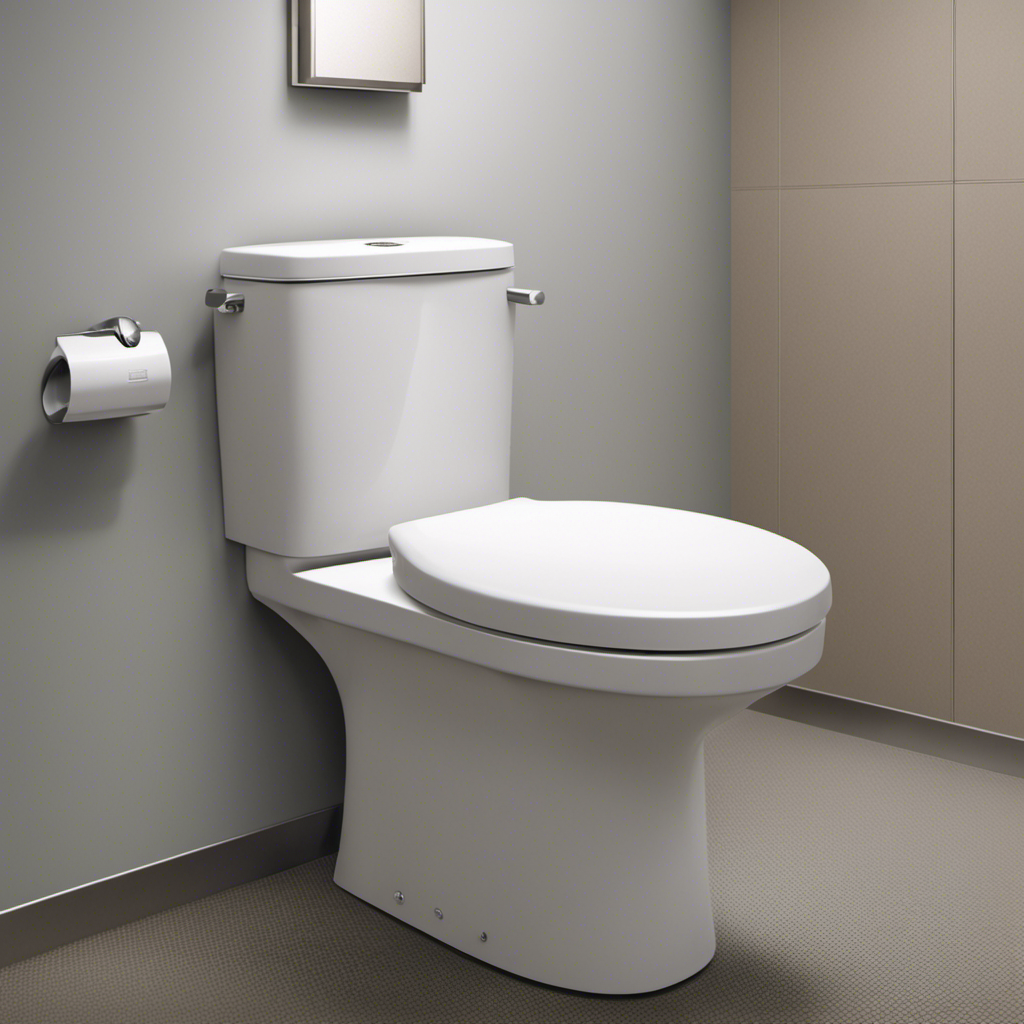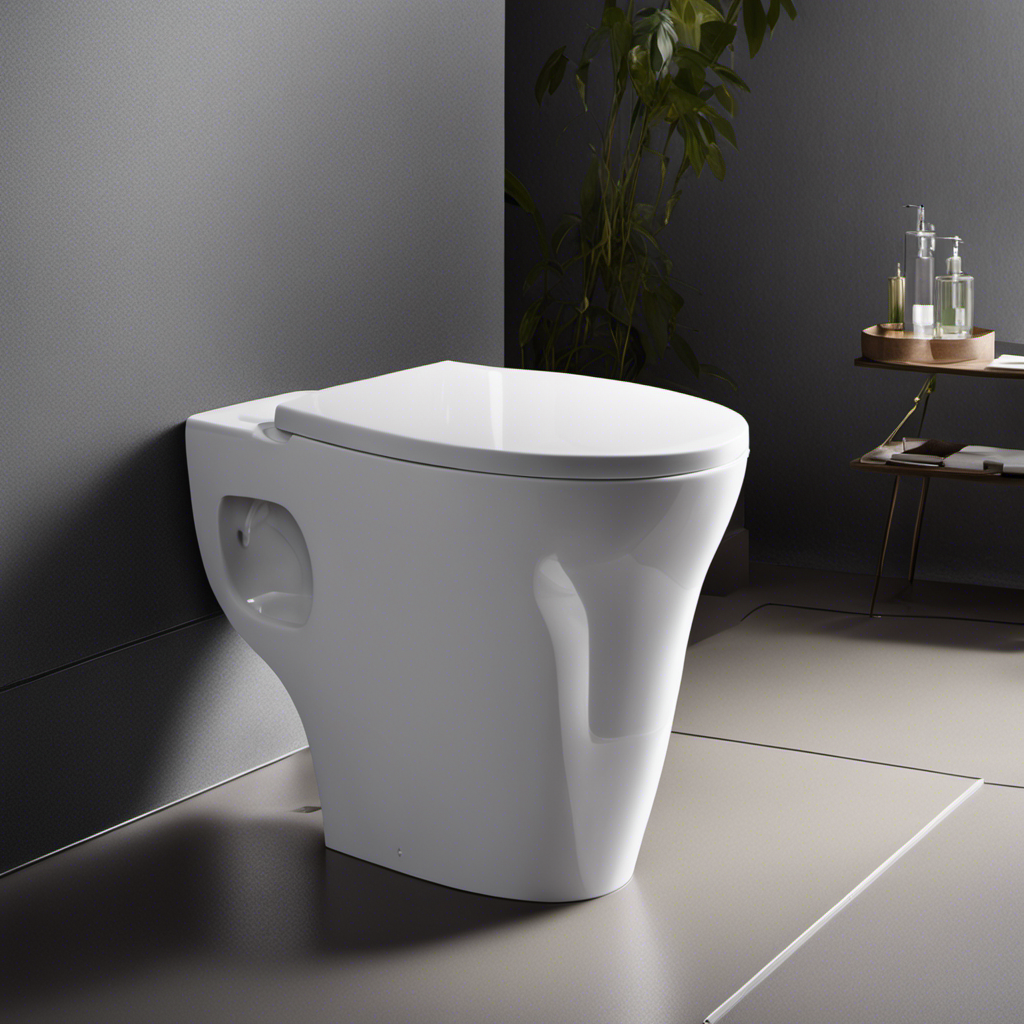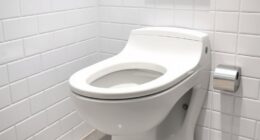- Water supply management
- Steps to prevent toilet water overflow
- Common causes and prevention of clogged drains.
- How to safely unclog a drain without using harmful chemicals
“Fixing a malfunctioning float valve”, “Indications of a malfunctioning float valve”
- Alternative methods for unclogging a toilet
- Common causes of toilet water being high
- Alternative remedies for unclogging toilets
- How to prevent toilet water from getting high in the first place
Do you find yourself facing the frustrating situation of a toilet with water levels that are alarmingly high? Fear not, for we have the solution!
In this article, we will guide you through a series of effective steps to take when encountering this predicament.
From shutting off the water supply and assessing the cause, to using plungers, augers, and even vinegar and baking soda mixtures, we’ll equip you with the tools and knowledge to tackle this issue head-on.
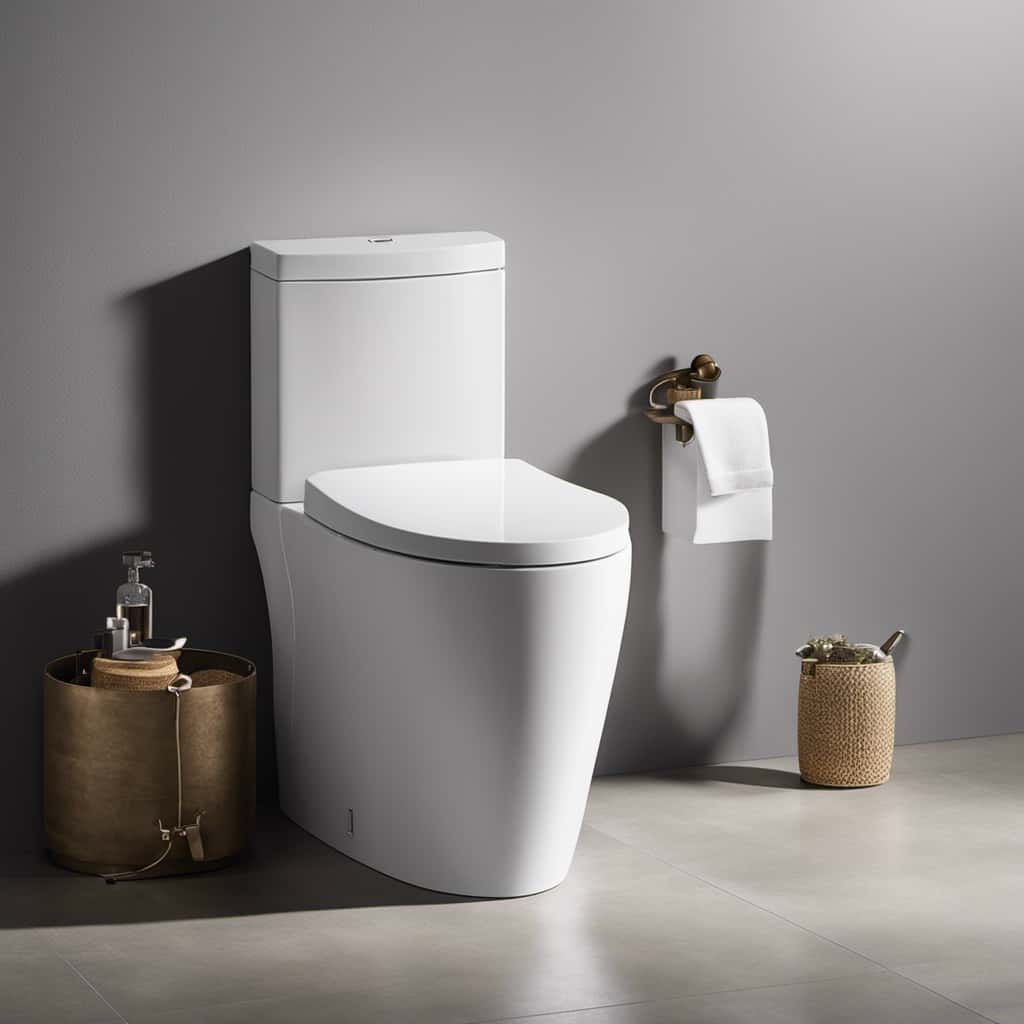
Let’s dive in and master the art of handling high toilet water levels!
Key Takeaways
- Locate and shut off the water supply valve to prevent further overflow and water damage.
- Assess the cause of the high water level, such as a clogged drain or faulty float valve.
- Unclog the toilet using a plunger, toilet brush, hot water, or a chemical reaction with baking soda and vinegar.
- Use tools like toilet augers or snakes to effectively clear stubborn clogs, ensuring proper technique and maintenance.
Shut off the Water Supply
To shut off the water supply, we need to locate the shut-off valve and turn it clockwise.
Water supply management is crucial to prevent toilet water overflow. By understanding the steps to shut off the water supply, you can effectively manage the situation.
First, find the shut-off valve, usually located behind the toilet or near the floor. Once located, turn the valve clockwise until it’s fully closed. This action stops the water flow to the toilet, preventing any further overflow.

It’s essential to act swiftly to avoid water damage and potential flooding. Regularly inspecting and maintaining the shut-off valve ensures its proper functioning.
Assess the Cause of the High Water Level
Now let’s take a closer look at the possible causes of a high water level in your toilet.
There are two main culprits that could be at play here: a clogged drain or pipe, or a faulty float valve.
These issues can lead to a build-up of water in the toilet bowl, causing it to rise higher than normal.

Let’s delve into each of these scenarios and explore the best course of action for each.
Clogged Drain or Pipe
We need to assess the cause of the high water level in the toilet by determining if there’s a clogged drain or pipe. When dealing with a clogged drain, it’s important to understand common causes and take preventive measures.
Some common causes of clogged drains include the buildup of hair, soap scum, and food particles. To prevent clogs, regularly clean drains and avoid flushing non-flushable items. If you encounter a clogged drain, it’s possible to safely unclog it without resorting to harmful chemicals. Simple methods like using a plunger or a drain snake can effectively clear the blockage. By following these techniques, you can address a clogged drain and ensure proper water flow.
Now let’s move on to discuss the next potential cause of high water level in the toilet: a faulty float valve.
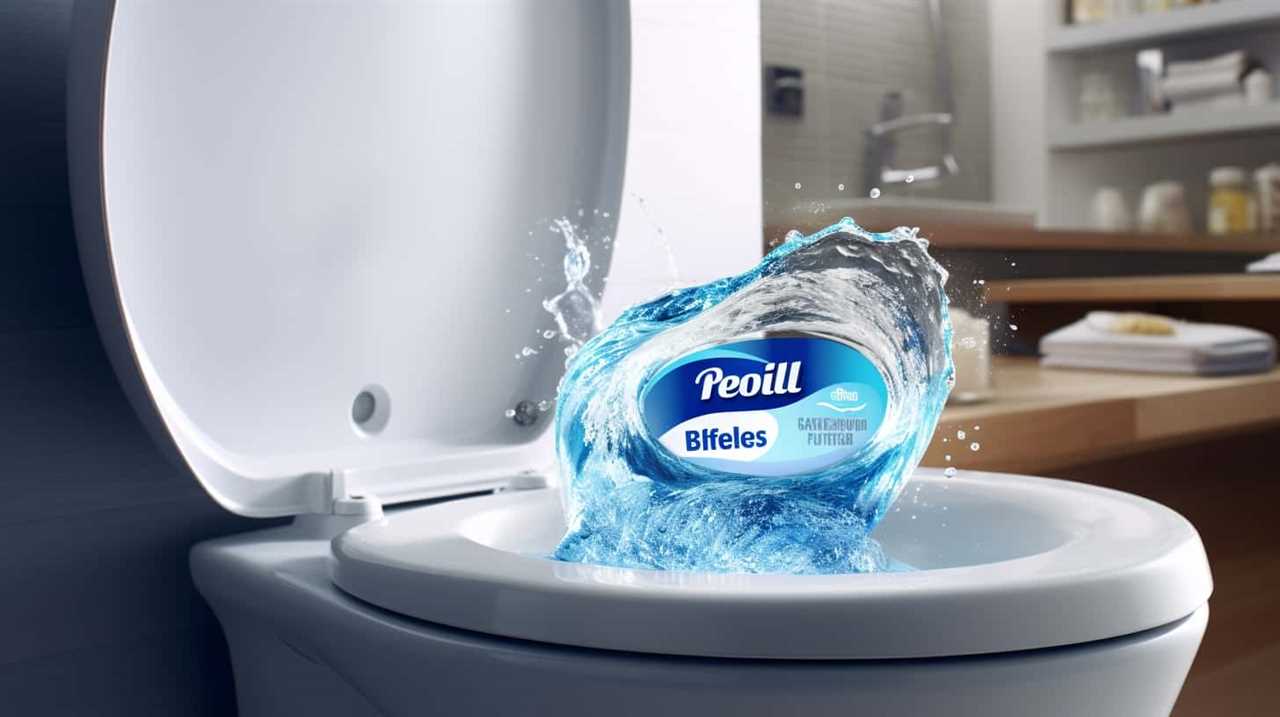
Faulty Float Valve?
After assessing for a clogged drain or pipe, we need to investigate if a faulty float valve could be causing the high water level in the toilet.
Repairing a faulty float valve is crucial to ensure the proper functioning of the toilet. Signs of a faulty float valve include constant running water, inconsistent water levels, or water overflowing from the tank.
To fix the issue, start by shutting off the water supply to the toilet. Remove the lid from the tank and locate the float valve. Inspect for any visible damage or debris that might be affecting its operation. Clean or replace the float valve if necessary. Adjust the float arm to ensure the proper water level in the tank.
Use a Plunger to Try and Unclog the Toilet
To begin tackling the issue of high toilet water, let’s grab a plunger and give it a try. Using a plunger is often the first line of defense when dealing with a clogged toilet.
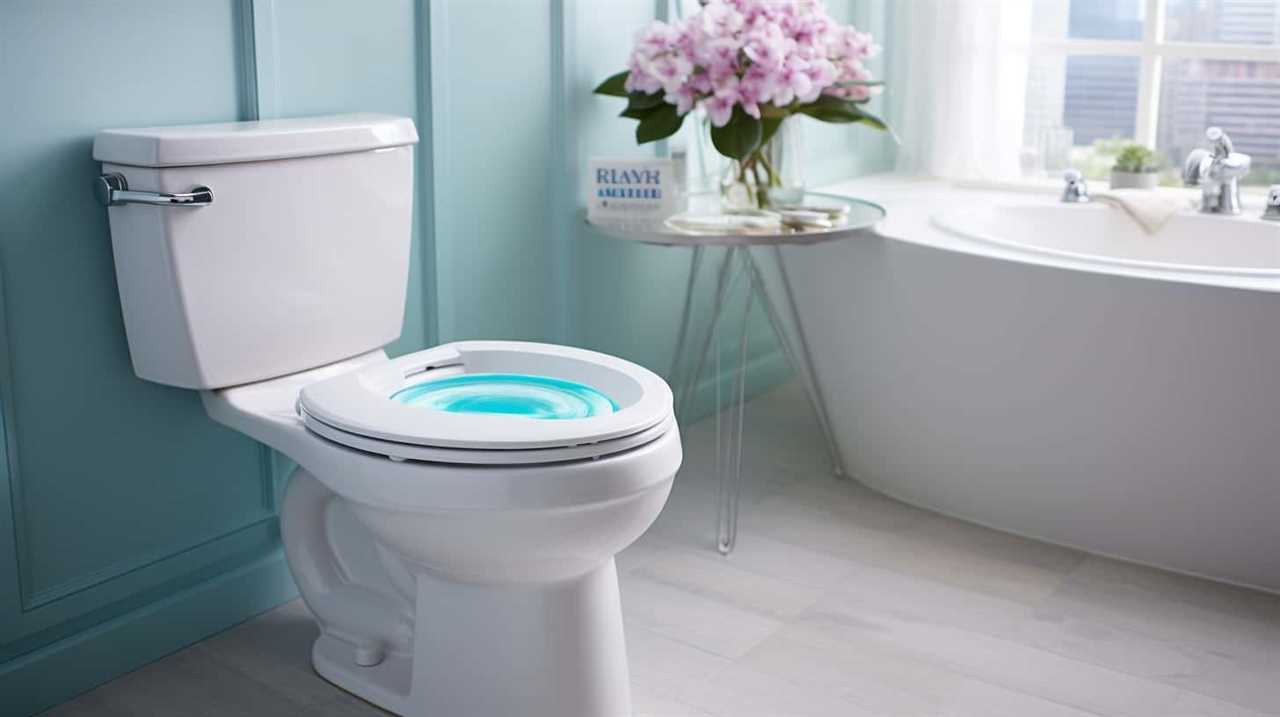
Here are some discussion ideas to consider:
- Alternative methods for unclogging a toilet:
- Using a toilet brush to break up the clog.
- Pouring hot water into the bowl to dissolve the blockage.
- Trying a mixture of baking soda and vinegar to create a chemical reaction that can clear the obstruction.
- Common causes of toilet water being high:
- Excessive toilet paper usage.
- Flushing non-flushable items.
- Build-up of mineral deposits in the pipes.
Try a Toilet Auger or Snake for Stubborn Clogs
If the plunger fails to resolve the issue, we can try using a toilet auger or snake to tackle stubborn clogs.
Toilet augers and snakes are essential tools for clearing blockages in the toilet drainpipe. A toilet auger consists of a long, flexible cable with a coiled end that can be inserted into the toilet bowl. To use it, we need to insert the auger into the drain and turn the handle clockwise. This action will break up and dislodge the clog, allowing it to be flushed away.
It’s important to maintain the toilet auger by cleaning it thoroughly after each use and storing it in a dry place.
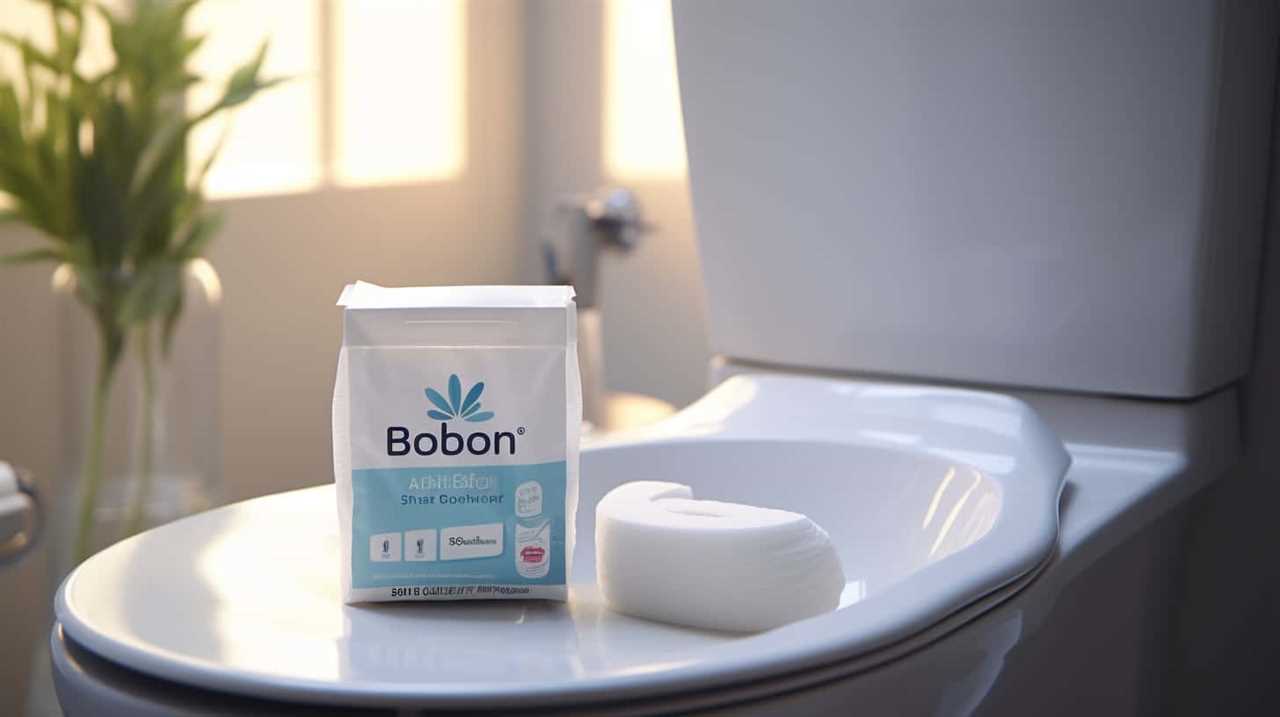
On the other hand, troubleshooting toilet snake usage involves ensuring that the snake is properly inserted into the drain, using the right technique to maneuver it, and avoiding excessive force that could damage the toilet.
Use a Mixture of Vinegar and Baking Soda to Dissolve the Clog
To effectively dissolve the clog, we can utilize a mixture of vinegar and baking soda. This natural remedy isn’t only effective but also safe for your plumbing system. Here are some discussion ideas about this subtopic:
- Vinegar and baking soda create a foaming reaction that helps break down the clog, allowing it to be easily flushed away.
- This method is an alternative to using harsh chemicals, which can damage pipes and the environment.
- By using vinegar and baking soda, you can save money on expensive drain cleaners and professional plumbing services.
While this mixture is effective, it’s important to note that prevention is key. To prevent toilet water from getting high in the first place, consider:
- Avoid flushing excessive amounts of toilet paper or non-flushable items.
- Regularly maintain your plumbing system by cleaning the toilet and inspecting for any signs of clogs or leaks.
- If you have recurring clogs, consider installing a drain strainer to catch debris before it enters the pipes.
Use a Wet/Dry Vacuum to Remove Excess Water
We can further address the issue of high toilet water by utilizing a wet/dry vacuum to efficiently remove the excess water.

This method is a reliable and effective way to prevent toilet overflow and minimize potential water damage.
When faced with a toilet that’s overflowing or has a high water level, using a wet/dry vacuum can help quickly and safely remove the excess water.
It’s important to note that when using a wet/dry vacuum, it’s crucial to ensure that it’s specifically designed for wet applications. This will prevent any damage to the vacuum or potential electrical hazards.
In the absence of a wet/dry vacuum, alternative methods such as using a bucket or towels to manually remove the water can be considered, but these may not be as efficient or effective as a wet/dry vacuum.

Call a Professional Plumber if DIY Methods Don’t Work
If the wet/dry vacuum method fails to resolve the issue of high toilet water, our best course of action is to call a professional plumber. While it can be tempting to continue attempting DIY methods, it’s important to recognize the signs of a plumbing emergency and know when to call in an expert.
Here are some common causes of high toilet water levels and how to prevent them:
- Clogged sewer line: A professional plumber can use specialized tools to clear the blockage and restore normal water flow.
- Faulty fill valve: A plumber can inspect the toilet’s fill valve and make any necessary adjustments or replacements.
- Sewer line breakage: If the high water level persists, it could indicate a break in the sewer line. A professional plumber can assess the situation and perform repairs if needed.
If DIY methods haven’t resolved the issue, it’s time to rely on the expertise of a professional plumber to ensure a proper and lasting solution.
Now, let’s move on to the next step: checking the toilet’s fill valve and adjusting it if necessary.
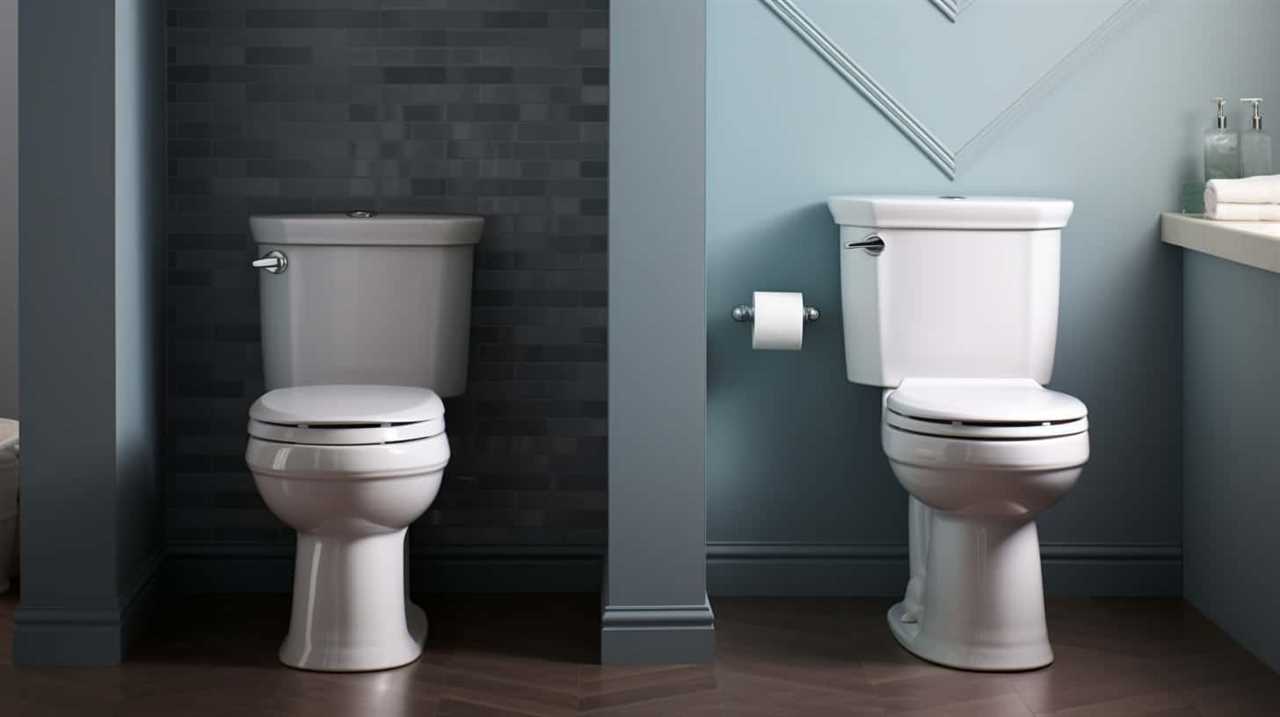
Check the Toilet’s Fill Valve and Adjust if Necessary
To address the issue of high toilet water, let’s start by examining and making any necessary adjustments to the toilet’s fill valve. The fill valve is responsible for controlling the water level in the toilet tank.
If the water level is too high, it may be due to a faulty fill valve that isn’t shutting off properly. To check the toilet water level, remove the tank lid and observe the water level. It should be around one inch below the overflow tube. If it’s higher, you’ll need to adjust the fill valve.
Locate the adjustment screw on top of the fill valve and turn it clockwise to decrease the water level or counterclockwise to increase it. Make small adjustments until the water level is within the recommended range. Remember to flush the toilet and check the water level again to ensure it’s properly adjusted.
Adjusting the fill valve can help resolve the issue of high toilet water and prevent any potential overflow.

Inspect the Flapper Valve for Any Issues
Upon inspecting the toilet’s fill valve and adjusting it if necessary, the next step is to examine the flapper valve for any issues. The flapper valve is responsible for controlling the water flow from the tank to the bowl. If there are problems with the flapper valve, it can lead to a high water level in the toilet.
To troubleshoot the toilet water level and ensure the proper functioning of the flapper valve, follow these steps:
- Check for any visible signs of damage or wear on the flapper valve.
- Ensure that the flapper valve is properly aligned and seated on the flush valve opening.
- Test the flapper valve by manually lifting it and observing if it closes tightly after releasing.
Check the Flush Handle and Chain for Proper Function
First, we will examine the flush handle and chain to ensure proper function. The flush handle is the lever we use to initiate the flushing process, while the chain connects the handle to the flapper valve. A malfunctioning handle or a loose chain can disrupt the flushing mechanism, leading to high toilet water levels. To diagnose and resolve any issues, refer to the table below:
| Problem | Solution |
|---|---|
| Flush handle is loose | Tighten the nut holding the handle in place |
| Flush handle is broken | Replace the flush handle with a new one |
| Chain is too long | Adjust the chain length by moving the hook to a closer link |
| Chain is tangled or disconnected | Reattach or untangle the chain for smooth operation |
Once you have checked and fixed any problems with the flush handle and chain, you can proceed to the next step: replacing any faulty or worn-out toilet parts.

Replace Any Faulty or Worn-Out Toilet Parts
After addressing any issues with the flush handle and chain, we’ll now move on to replacing any faulty or worn-out toilet parts. When the toilet water level is high, it can be a cause for concern as it increases the risk of water overflow. To prevent this from happening, it’s crucial to replace any faulty or worn-out parts.
Here are three key reasons why this is important:
- Prevent water damage: Faulty toilet parts can lead to water leaks and potential damage to your bathroom floor and walls. By replacing these parts promptly, you can avoid costly repairs and maintain the integrity of your bathroom.
- Ensure proper flushing: Worn-out toilet parts can affect the flushing mechanism, resulting in inadequate water flow and inefficient waste removal. By replacing these parts, you can ensure the toilet flushes properly and reduces the risk of clogs.
- Maintain water efficiency: Faulty parts can cause the toilet to use more water than necessary, leading to higher water bills. By replacing these parts, you can restore the toilet’s water efficiency and contribute to water conservation.
Consider Installing a Toilet Overflow Prevention Device
Now, let’s move on to the next step in managing high toilet water levels by considering the installation of a toilet overflow prevention device. This device is designed to prevent water from overflowing and causing damage to your bathroom floor and surrounding areas. It is an essential addition to your toilet system, especially if you have experienced overflow issues in the past.
Toilet overflow prevention devices work by automatically shutting off the water supply when the water level reaches a certain point. This helps to prevent any potential flooding and damage. Regular maintenance of these devices is crucial to ensure their proper functioning. It is recommended to inspect and clean the device regularly to remove any debris or mineral deposits that may hinder its performance.
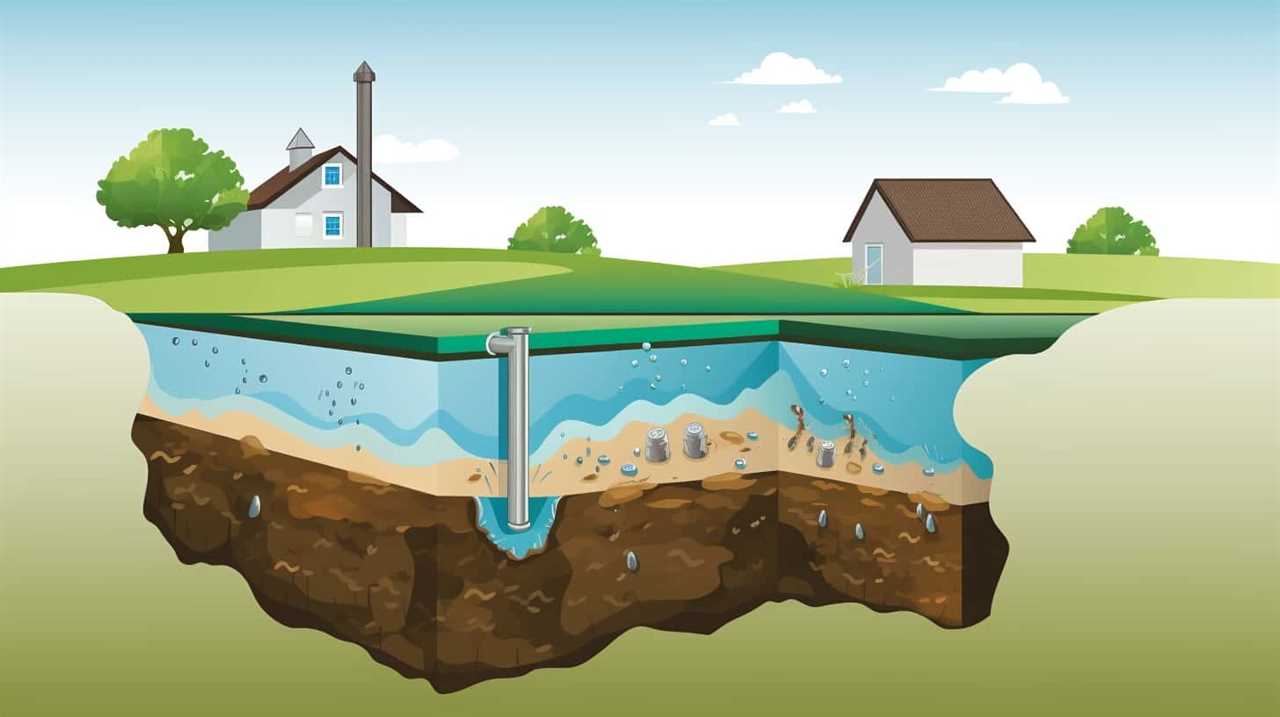
Below is a table showcasing the importance of regular maintenance for toilet overflow prevention devices:
| Importance of Regular Maintenance for Toilet Overflow Prevention Devices | ||
|---|---|---|
| Prevents water damage to floors and surrounding areas | Ensures proper functioning of the device | Extends the lifespan of the device |
Practice Preventative Maintenance to Avoid Future High Water Levels
To avoid future high water levels in your toilet, we can practice preventative maintenance. By following these preventative maintenance tips, you can ensure that your toilet operates smoothly and efficiently:
- Regularly inspect the float valve: Make sure the float valve is functioning properly and not sticking. If it is, clean or replace it to prevent water from continuously flowing into the tank.
- Check the fill valve: Ensure that the fill valve is adjusted correctly to maintain the appropriate water level in the tank.
- Clear clogs promptly: Blockages in the drain pipe can cause water to back up and result in high water levels. Use a plunger or a plumbing snake to clear any clogs.
Frequently Asked Questions
How Do I Shut off the Water Supply to My Toilet?
To shut off the water supply to the toilet, locate the shut off valve. Turn it clockwise until it is fully closed. This will prevent water overflow and allow you to address the problem.
What Are Some Common Causes of High Water Levels in Toilets?
Toilet water overflow can be caused by various toilet tank issues. One common cause is a faulty fill valve that fails to shut off the water supply. We should address this promptly to prevent further damage.

Can a Plunger Effectively Unclog a Toilet?
A plunger can often unclog a toilet by creating suction to dislodge the blockage. However, if it doesn’t work, there are plunger alternatives available or you can consider professional plumbing services.
When Should I Use a Toilet Auger or Snake for Stubborn Clogs?
When facing stubborn clogs, toilet auger alternatives like a plunger may be effective. However, if a plunger fails, using a toilet auger or snake can help unclog toilets without damaging the plumbing system.
How Can I Prevent Future High Water Levels in My Toilet?
To prevent overflow and adjust water level in our toilet, we can use the water level adjustment valve. By turning it clockwise, we can decrease the water level, ensuring it doesn’t reach a high level.
Conclusion
In conclusion, dealing with a high water level in the toilet can be a frustrating experience. However, by following the steps outlined in this article, you can effectively address the issue and prevent future occurrences.
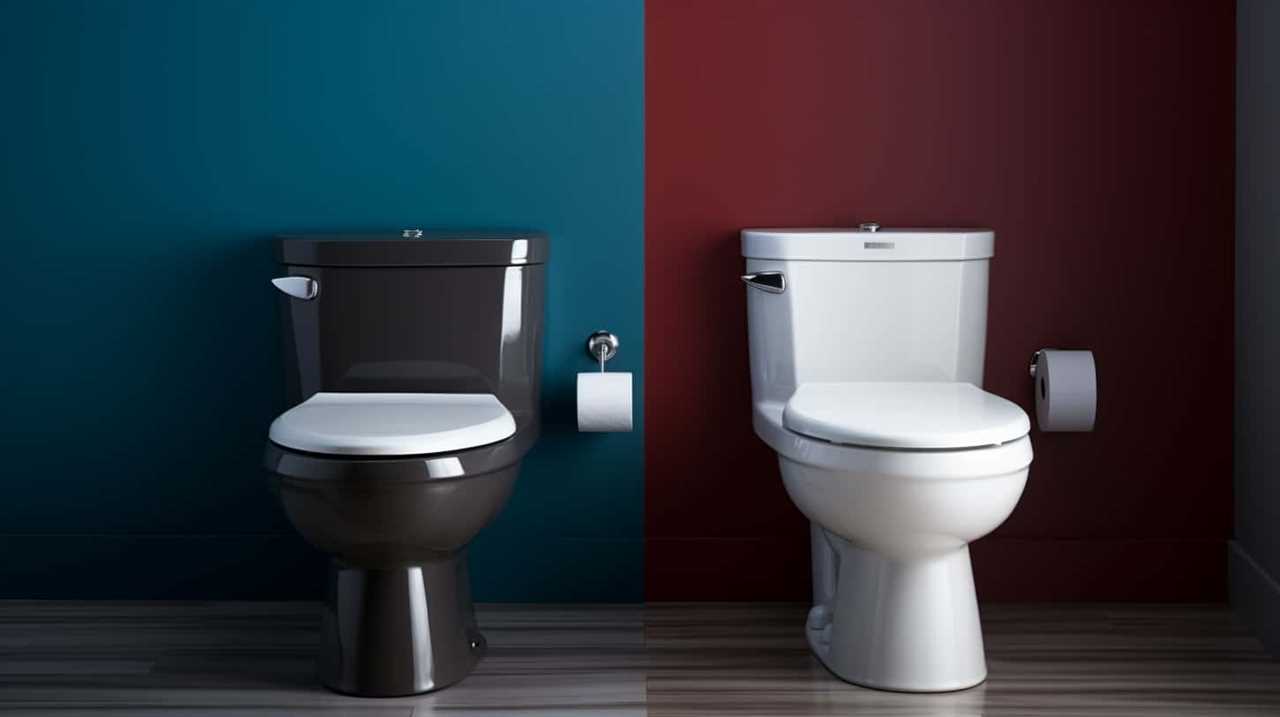
Remember to shut off the water supply, assess the cause, use a plunger or auger, and consider installing an overflow prevention device.
By practicing preventative maintenance, you can ensure a smoothly functioning toilet and avoid unpleasant surprises in the future.
Happy plumbing!




